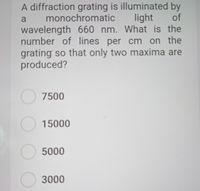
College Physics
11th Edition
ISBN: 9781305952300
Author: Raymond A. Serway, Chris Vuille
Publisher: Cengage Learning
expand_more
expand_more
format_list_bulleted
Concept explainers
Question

Transcribed Image Text:A diffraction grating is illuminated by
monochromatic
light of
wavelength 660 nm. What is the
number of lines per cm on the
grating so that only two maxima are
produced?
O 7500
15000
5000
3000
Expert Solution
This question has been solved!
Explore an expertly crafted, step-by-step solution for a thorough understanding of key concepts.
This is a popular solution
Trending nowThis is a popular solution!
Step by stepSolved in 2 steps with 2 images

Knowledge Booster
Learn more about
Need a deep-dive on the concept behind this application? Look no further. Learn more about this topic, physics and related others by exploring similar questions and additional content below.Similar questions
- A thin film of glycerin (n = 1.473) of thickness 486 nm with air on both sides is illuminated with white light at near normal incidence. What wavelengths will be strongly reflected in the range 300 nm to 700 nm? nm (smallest value) nm nm (largest value)arrow_forwardYou will view a source of white light through a diffraction grating that has 1000 lines/mm. (a) Find the angles that contain the visible spectrum at 1st order. (b) You can’t see the entire spectrum at 2nd order. What is the last wavelength that is visible, assuming you can see out to 90 degrees. What color is that?arrow_forwardE17P8arrow_forward
- You measure three segments of the distance between a diffraction slit an the screen on which the pattern forms: x1 = (15.8 ± 0.2) cm, x2 = (6.7 ± 0.1) cm, and x3 = (11.3 ± 0.1). What is the uncertainty of the total distance x1 + x2 + x3? Group of answer choices 0.4 cm 0.5 cm 0.2 cm 0.3 cm 0.1 cmarrow_forward33. You have a laser (a monochromatic light source) and want to estimate the wavelength. You decide to use a reflective diffraction grating to do this. The light is incident on the grating at 20 degrees with respect to normal. Using a grating with a groove distance of 5 um, the first-order diffraction, is found at an angle of -12.5 degrees. Determine the wavelength of the source. a) 500 nm b) 628 nm c) 808 nm d) 946 nm e) None of the above 34. In Raman spectrometry, Stokes lines have a) lower energy than that of anti-Stokes scattering. b) equal energy to that of anti-Stokes scattering. ) higher energy than that of anti-Stokes scattering d) none of the above 35. Upon ionization of phenol in aqueous solution, maximal UV absorbance changes to longer wavelength. a) True b) False 36. It takes longer time to observe fluorescence than phosphorescence. a) True b) False 37. The vibrational motion of C-H stretching in ethylene as in the figure can be detected by a) IR. b) Raman. c) IR and Raman.…arrow_forwardA double slit is illuminated with monochromatic light of wavelength 6.00 × 102 nm. The m = 0 and m = 1 bright fringes are separated by 3.0 cm on a screen which is located 4.0 m from the slits. What is the separation between the slits? Question 24 options: 4.0 × 10−5 m 1.2 × 10−4 m 2.4 × 10−4 m 8.0 × 10−5 m 1.6 × 10−4 marrow_forward
- Light from an argon laser strikes a diffraction grating that has 4,300 grooves per centimeter. The central and first-order principal maxima are separated by 0.444 m on a wall 1.67 m from the grating. Determine the wavelength of the laser light. 597.5 nm 510.7 nm 440.3 nm 363.9 nmarrow_forwardA thin film of glycerin (n = 1.473) of thickness 536 nm with air on both sides is illuminated with white light at near normal incidence. What wavelengths will be strongly reflected in the range 300 nm to 700 nm? nm (smallest value) nm nm (largest value) Need Help? Read Itarrow_forwardA diffraction grating with unknown number of lines per mm is illuminated by light at a wavelength = 633 nm and the first order diffraction pattern is seen at an angle B = 50.0°. Light of a second wavelength is shone onto the grating, whose second order diffraction pattern is seen at y = 60.0°. What is the wavelength of this second beam? 358 nm 392 nm 716 nm 548 nm 272 nmarrow_forward
arrow_back_ios
arrow_forward_ios
Recommended textbooks for you
 College PhysicsPhysicsISBN:9781305952300Author:Raymond A. Serway, Chris VuillePublisher:Cengage Learning
College PhysicsPhysicsISBN:9781305952300Author:Raymond A. Serway, Chris VuillePublisher:Cengage Learning University Physics (14th Edition)PhysicsISBN:9780133969290Author:Hugh D. Young, Roger A. FreedmanPublisher:PEARSON
University Physics (14th Edition)PhysicsISBN:9780133969290Author:Hugh D. Young, Roger A. FreedmanPublisher:PEARSON Introduction To Quantum MechanicsPhysicsISBN:9781107189638Author:Griffiths, David J., Schroeter, Darrell F.Publisher:Cambridge University Press
Introduction To Quantum MechanicsPhysicsISBN:9781107189638Author:Griffiths, David J., Schroeter, Darrell F.Publisher:Cambridge University Press Physics for Scientists and EngineersPhysicsISBN:9781337553278Author:Raymond A. Serway, John W. JewettPublisher:Cengage Learning
Physics for Scientists and EngineersPhysicsISBN:9781337553278Author:Raymond A. Serway, John W. JewettPublisher:Cengage Learning Lecture- Tutorials for Introductory AstronomyPhysicsISBN:9780321820464Author:Edward E. Prather, Tim P. Slater, Jeff P. Adams, Gina BrissendenPublisher:Addison-Wesley
Lecture- Tutorials for Introductory AstronomyPhysicsISBN:9780321820464Author:Edward E. Prather, Tim P. Slater, Jeff P. Adams, Gina BrissendenPublisher:Addison-Wesley College Physics: A Strategic Approach (4th Editio...PhysicsISBN:9780134609034Author:Randall D. Knight (Professor Emeritus), Brian Jones, Stuart FieldPublisher:PEARSON
College Physics: A Strategic Approach (4th Editio...PhysicsISBN:9780134609034Author:Randall D. Knight (Professor Emeritus), Brian Jones, Stuart FieldPublisher:PEARSON

College Physics
Physics
ISBN:9781305952300
Author:Raymond A. Serway, Chris Vuille
Publisher:Cengage Learning

University Physics (14th Edition)
Physics
ISBN:9780133969290
Author:Hugh D. Young, Roger A. Freedman
Publisher:PEARSON

Introduction To Quantum Mechanics
Physics
ISBN:9781107189638
Author:Griffiths, David J., Schroeter, Darrell F.
Publisher:Cambridge University Press

Physics for Scientists and Engineers
Physics
ISBN:9781337553278
Author:Raymond A. Serway, John W. Jewett
Publisher:Cengage Learning

Lecture- Tutorials for Introductory Astronomy
Physics
ISBN:9780321820464
Author:Edward E. Prather, Tim P. Slater, Jeff P. Adams, Gina Brissenden
Publisher:Addison-Wesley

College Physics: A Strategic Approach (4th Editio...
Physics
ISBN:9780134609034
Author:Randall D. Knight (Professor Emeritus), Brian Jones, Stuart Field
Publisher:PEARSON